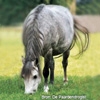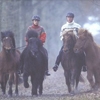|
Advice article filter
|
Horse too fat, losing weightYou exercise your horse seriously and regularly, your horse does not get too much hard feed and still, he is a good-doer. To instigate a tight diet seems to be the only option, but it is definitely not the best approach to let your horse loose weight. So, what is the best way? Do’s and Don’ts Do
Don’t
The key is to give your horse sufficient roughage and a lot movement Stabled horses who only eat a small amount of roughage get bored and develop stable vices like cribbing, wind sucking or weaving. In the wild, horses live in herds and graze and move around 16 hours a day. A stable vice can suddenly appear when you limit your horse in it’s natural behaviour. As opposed to human beings, horses don’t produce saliva when they don’t chew. Saliva neutralises the stomach acids, so no chewing means no saliva, which then gives the stomach acids the opportunity to produce ulcers in the lining of the stomach. Those ulcers are painful and to compensate, the horse starts wind sucking or cribbing to produce saliva. Movement uses energy. The only way to have your horse use more energy is to do a lot of work with him. A grass belly disappears quickly when you exercise your horse intensively for 20 minutes every day. Be careful with hyperlipemia Hyperlipemia or ‘diet disease’ especially occurs within the native breeds. It could happen when your horse looses weight too quickly. When a horse does not get sufficient nutrients, it starts using it’s own fat reserves. This could disturb the fat metabolism and as a result too many fatty substances appear in the bloodstream. If that is the case, your horse or pony will stop eating and drinking and that is, of course, very dangerous. Be creative How can you ensure that your horse can eat a lot of roughage, spread over the whole day, does a lot of chewing and still keeps the correct weight, because he does not obtain more energy than he needs? Use hay with rough stems If you are in a position to choose, take the rough stems instead of fine hay. Hay with rough stems has a lower feeding value. Many small portions of roughage per day Avoid periods longer than 8 hours between meals. That does imply another hay or haylage net later in the evening. If you are not able to do that yourself, try to find somebody else for the evening shift. In summer: limited grazing Unlimited grass could be the major reason for a horse becoming fat. Limit hard feed Use low energy hard feed, like Pavo Nature’s Best (without oats, low protein content and low in sugar). A lazy and fat horse; what to do? An overweight horse is sometimes also lazy. Often more hard feed is given to these horses with the aim to give the horse more energy. That however doesn’t work. Make a plan! Prepare a plan for the feeding regime and the fitness programme, and stick to it.   |

